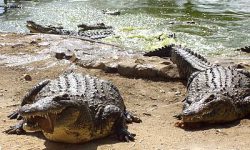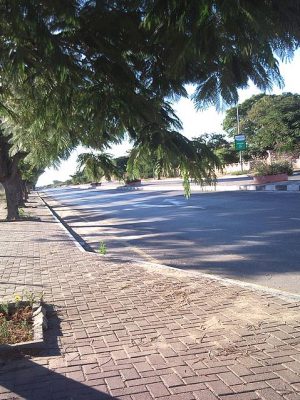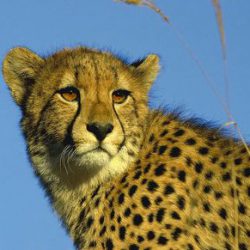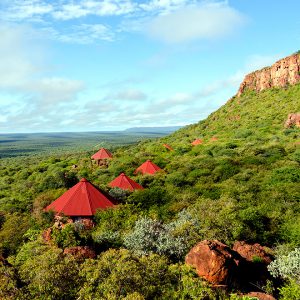Bush Pillow Guest House
Bush Pillow Guest House is an up market Guest House situated in the center of the Cheetah Capital, Otjiwarongo. It is the perfect retreat for the discerning tourist, business executive or…
The crocodile farm near the eastern border of town is a top attraction where you can observe and photograph crocodiles at close range and learn about the breeding habits of these reptiles. The ranch exports the skins, but sells the meat locally. Meet, photograph and learn more about these remarkable reptiles, and browse around the gift shop.

Otjiwarongo, as it is known today, came into existence mainly because of the need to find a connection between Swakopmund, Windhoek and Tsumeb. The powers that that were (Germany) knew about the copper ore in the Otavi (Tsumeb) area and they needed to get the ore to the coast for shipping back to Germany. At first, they wanted to develop Port Alexander, but that was 730 kilometers from Otavi and Swakopmund was only 581 kilometers away. The Germans also knew what South Africa was like, but they did not have good faith in the future Angola.
They did however also keep options open in case trouble presented itself with South Africa and thus it was imperative that the rail road was built via Outjo. Another factor to consider was Waterberg area, with enough water and fertile soil it was seen as a growth point. Thus based on these factors the decision was taken to establish the link between Waterberg and Outjo 378 kilometers (Otjiwarongo).
The narrow gauge rail was completed in 1906 and the first train arrived on the 2nd April 1906.
Otjiwarongo settled down and at that same year the Post Office and Police station was opened. The first inhabitants were Hans Beurger, Julius Doll, August Laszig and Paul Witt.
One of the locomotives that served that first community and town was given the honorary spot in front of the station building in Otjiwarongo. The narrow gauge served Otjiwarongo from 1906 to 1960. Many stories is told by some of the towns people even today every time a story is told one can see a special glimmer in the eyes of the story teller of the reminders of an era gone by. One of these stories tells about the first rail accident that was recorded in 1906. Apparently, the investigating team found that passenger Suessmann handed the driver a case of beer for the road between Usakos and Otjiwaronog, because, in those days, the journey could be long and arduous and one could become thirsty!
In front of the station you can see the old steam engine No. 41, built in 1912 by the Henschel company in Kassel, Germany. It used to run on the railway line from Swakopmund to Otavi.

Situated in the Otjiwarongo area, are some of Namibia’s most reputable private game farms and reserves with integrated luxurious lodges. East of town, at the Waterberg Massif, many farms have conglomerated to form the “Waterberg Conservancy”; a game and nature protection area of more 200 000 hectares in size. The Cheetah Conservation Fund CCF, which is specifically dedicated to the survival of cheetahs, has established an information centre there. They welcome day visitors who can meet and learn more about cheetahs and cheetah conservation in Namibia. A gift shop is also available. Visit their website at http://www.cheetah.org for more information. The Cheetah Conservation offers several options to view and understand cheetahs.
Namibia has the largest remaining population of free-ranging cheetahs, some 2 500, in the world. About 50 miles from Otjiwarongo you will find Okonjima, the home of the Africat Foundation, a successful cheetah and leopard rehabilitation centre, with viewing made possible by staying at the adjacent Okonjima Lodge.

About 90km drive from Otjiwarongo and set at the foot of the massive and picturesque Waterberg Plateau, this is well worth a stay-over. There are hiking trails and plenty of wild life and birds to be seen. The breath-taking Waterberg Plateau rises about 200m above the surrounding landscape. It is a game and nature protection area and habitat to Namibia’s only breeding colony of Cape vulture. It is situated about 50km east of Otjiwarongo. Guided tours are available, but day visitors should make prior arrangements for their expected visit to the camp. There are also guided game drives onto the plateau. The views are spectacular, and one often catches a glimpse of Sable Antelope.

Bush Pillow Guest House is an up market Guest House situated in the center of the Cheetah Capital, Otjiwarongo. It is the perfect retreat for the discerning tourist, business executive or…
Casa Forno Country Hotel is is a beautiful, upmarket bed and breakfast situated in Otjiwarongo, Namibia. It is the traveller’s home away from home and the doorstep to Namibia’s North.…
Our African-styled hotel accommodation & restaurant is situated in Otjiwarongo, cheetah capital of the world. Make yourself at home in our Namibian lodge-style atmosphere with thatched roofs, beautiful gardens and…
Frans Indongo Lodge is host to 14 gorgeously decorated Rooms and Chalets, exuding the sense of life of Northern Namibia… Find out what activities you can keep yourself busy with…
The ideal gateway for any visitor to Northern Namibia, a stop over before heading towards the unique Water Berg Plateau park, the world famous Etosha National Park, the Vingerklip, Twyfelfontein…
Lion’s Den Guesthouse is the perfect stopover destination and its location is just 5 Km outside Otjiwarongo on the B1 road on the way to Etosha National Park that makes…
Discover the perfect Namibian oasis at Otjibamba Lodge, a beloved stopover on your journey to Etosha National Park. Only 180km away from the park, our lodge offers a tranquil escape…